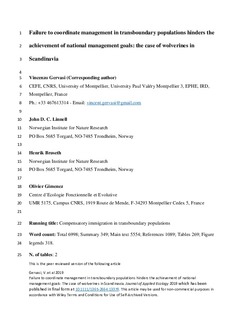| dc.contributor.author | Gervasi, Vincenzo | |
| dc.contributor.author | Linnell, John D.C. | |
| dc.contributor.author | Brøseth, Henrik | |
| dc.contributor.author | Gimenez, Olivier | |
| dc.coverage.spatial | Norway, Sweden, Scandinavia | nb_NO |
| dc.date.accessioned | 2019-04-01T12:10:32Z | |
| dc.date.available | 2019-04-01T12:10:32Z | |
| dc.date.issued | 2019-03-09 | |
| dc.identifier.issn | 0021-8901 | |
| dc.identifier.uri | http://hdl.handle.net/11250/2592717 | |
| dc.description.abstract | Large carnivores are expanding in Europe, and their return is associated with con- flicts that often result in policies to regulate their population size through culling. Being wide-ranging species, their populations are often distributed across several jurisdictions, which may vary in the extent to which they use lethal control. This creates the conditions for the establishment of source-sink dynamics across bor- ders, which may frustrate the ability of countries to reach their respective man- agement objectives. 2. To explore the consequences of this issue, we constructed a vec-permutation pro- jection model, applied to the case of wolverines in south-central Scandinavia, shared between Norway (where they are culled) and Sweden (where they are pro- tected). We evaluated the effect of compensatory immigration on wolverine pop- ulation growth rates, and if the effect was influenced by the distance to the national border. We assessed to what extent compensatory immigration had an influence on the number of removals needed to keep the population at a given growth rate. 3. In Norway, the model estimated a stable trend, whereas in Sweden it produced a 10% annual increase. The effect of compensatory immigration corresponded to a 0.02 reduction in population growth rate in Sweden and to a similar increase in Norway. This effect was strong closer to the Norwegian-Swedish border, but weakwhenmovingawayfromit.Anaverageof33wolverineswasshotperyear in the Norwegian part of the study area. If no compensatory immigration from Sweden had occurred, 28 wolverines shot per year would have been sufficient to achievethesamegoal.About15.5%ofalltheindividualsharvestedinNorway between 2005 and 2012 were compensated by immigrants, causing a decrease in population growth rate in Sweden. 4. Synthesis and applications. When a population is transboundary, the consequences of management decisions are also transboundary, even though the political bodies in charge of those decisions, the stakeholders who influence them, and the tax- payers who finance them are not. It is important that managers and citizens be informed that a difference in management goals can reduce the efficiency, and increase the costs, of wildlife management. | nb_NO |
| dc.language.iso | eng | nb_NO |
| dc.subject | compensatory immigration | nb_NO |
| dc.subject | density-dependent dispersal | nb_NO |
| dc.subject | source-sink dynamic | nb_NO |
| dc.subject | spatial harvest | nb_NO |
| dc.subject | transboundary management | nb_NO |
| dc.subject | policy | nb_NO |
| dc.subject | transboundary species | nb_NO |
| dc.subject | vec-permutation matrix model | nb_NO |
| dc.title | Failure to coordinate management in transboundary populations hinders the achievement of national management goals: The case of wolverines in Scandinavia | nb_NO |
| dc.type | Peer reviewed | nb_NO |
| dc.type | Journal article | |
| dc.description.version | acceptedVersion | nb_NO |
| dc.rights.holder | © 2019 The Authors. Journal of Applied Ecology © 2019 British Ecological Society | nb_NO |
| dc.subject.nsi | VDP::Matematikk og Naturvitenskap: 400::Zoologiske og botaniske fag: 480 | nb_NO |
| dc.source.journal | Journal of Applied Ecology | nb_NO |
| dc.identifier.doi | 10.1111/1365-2664.13379 | |
| dc.identifier.cristin | 1687875 | |
| dc.relation.project | Norges forskningsråd: 251112 | nb_NO |
